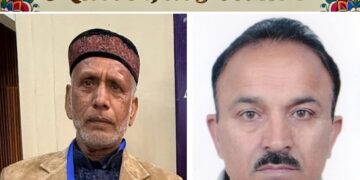Srinagar: The Central Sericultural Research & Training Institute (CSRTI), Pampore, under the Central Silk Board (CSB), Ministry of Textiles, Government of India, organized a Rajbhasha National Technical Seminar on “Technological Interventions for Improving Quality and Productivity of Silk Industry” at the Sher-e-Kashmir International Convention Centre (SKICC), Srinagar.
The seminar was inaugurated by Chief Guest P. Sivakumar, IFS, Chief Executive Officer and Member Secretary, Central Silk Board, and Director General, International Sericulture Commission. The event brought together scientists, researchers, and sericulture experts from across the country to deliberate on the latest innovations and sustainable practices for strengthening India’s silk sector.
In his inaugural address, Sivakumar highlighted the immense potential of bivoltine sericulture in Jammu & Kashmir, assuring that the Central Silk Board will extend all necessary technical and institutional support for its sustainable development. He lauded the superior quality of Kashmir silk and called for global branding, stronger market linkages, and enhanced domestic consumption through support for local artisans.
Emphasizing region-specific sericulture models, he urged for technology-driven interventions tailored to local climatic and farmer needs while promoting collaboration between research institutions and grassroots stakeholders. He noted that the CSB’s R&D institutes are developing technologies suited for temperate and high-altitude regions like Jammu, Kashmir, and Ladakh to make sericulture more resilient and economically viable.
Appreciating the efforts of the Sericulture Development Department, J&K, and CSRTI Pampore, Sivakumar said that Jammu & Kashmir has a rich tradition of silk production, and with coordinated effort and innovation, it can regain its historic place as a leading silk-producing hub in the country.
The event was also attended by several distinguished dignitaries, including Aijaz Ahmad Bhat, IAS, Director, Sericulture Development Department, Jammu and Kashmir; Dr. Sardar Singh, Director, CSB–Central Sericultural Research and Training Institute, Pampore (J&K); Dr. M.A. Khan, Director (Retd.), Central Silk Board; Mussarat Islam (JKAS), Director, Handicrafts and Handloom, Kashmir; K.P. Sharma, Joint Director, Rajbhasha Vibhag, Ministry of Home Affairs, Government of India, New Delhi; and Dr. Naresh Babu, IFS, Joint Secretary (Tech), Central Silk Board, Bengaluru.
The seminar also featured the release of three Hindi publications, Abstract Book (Smārika), Annual Hindi Magazine, and Half-Yearly Newsletter by the Chief Guest and dignitaries, promoting the use of Rajbhasha Hindi in scientific communication.
A total of 88 scientists from 20 states participated in the seminar, presenting their research findings through 34 oral presentations and 25 posters. Directors from nine R&D institutes of the Central Silk Board shared lead papers on Mulberry, Tasar, Muga, and Eri sericulture, as well as Post-Cocoon technologies and by-product utilization. The Rajbhasha Session included four presentations highlighting the importance of Hindi in science and technology.
This was the first Hindi technical seminar organized by the Central Silk Board in the Kashmir Valley, providing a vibrant platform for discussion on technological advancement, sustainability, and regional development in sericulture across North-West India.




